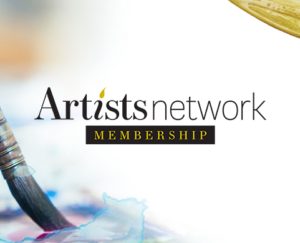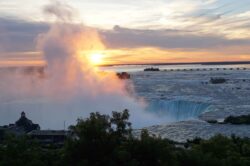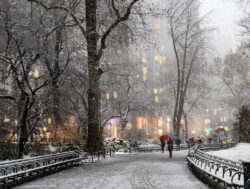Daniel Sprick: What Works for Me

At the age of 71, Colorado-based artist Daniel Sprick has devoted more than five decades to his work. Although he’s committed to continued growth, after so many brush miles, the artist has, of course, developed some regular practices and preferences. Here are a few of his thoughts on matters of method and materials.
By Colleen Smith
On Patience
“I let paintings sit a year or two without even looking at them,” Sprick says. “I’ll finish a painting—or think it’s finished—and set it aside. I look at it a year later and see so many things I could change. I come back to it having forgotten how much work it was—like the pain of childbirth, mercifully forgotten. After so much time has passed, I’m willing to obliterate big areas I’ve worked on that I put a lot of time into, and I can start over and rebuild, as if the painting is new. Having a lot of time in between helps.”
On Brushes
“I use cheap brushes,” Sprick says. “Occasionally, I use a brush called a cat’s tongue. It comes to a point, so you can do fine work or a broad stroke with the same brush, even in the same stroke, so that’s handy.”
On Titles
“Sometimes a title can help sell a picture, but generally I don’t think titles are important,” the artist says. “I’ll be sitting with an art dealer, and I’ve got to come up with titles, titles, titles, and I haven’t thought about titles the whole time I’ve been painting. I usually don’t. Honestly, I change my titles all the time. It depends on my mood.”
On Frames
Sprick has a strong preference for black frames. “The reason is that black accentuates the light in the picture,” he says. “Frames, in general, are a border to separate [the painting] from the rest of the visual world. That’s why I think frames are important. That’s why I like them. There’s a long tradition of framing art in really ornate, complicated frames, but I like frames that are relatively simple.”
On Color
A signature motif evident in Sprick’s work is the presence of pale yellow—a sulfuric color simultaneously uplifting and slightly sinister. “When I was first learning how to paint, my color was all chalky, and I couldn’t get good, rich colors,” Sprick says. Then, while studying at the University of Northern Colorado, a painting instructor gave him a tip. “Rod Goebel told me to ‘mix yellow into all your white,’ and I’ve been doing it ever since,” Sprick says. “Of all the colors on the palette, yellow is, at full saturation, the lightest value. It’s the brightest and closest to white—especially cadmium yellow pale. It maintains quite a bit of saturation, even with a lot of white mixed in. I like a glow, and white with yellow glows like no other color.” You’ll see this pale yellow glowing in his paintings of surreal skies, interior walls or a creamy leather couch, on skulls and skeletons, and dishes and draperies.
On Lighting
Recently, Sprick started working with new lighting in his studio. “I’ve got this theater spotlight,” he says. “The framing shutters can make the light crisp and linear or soft, so the cast shadows from objects are crisper.” He accomplishes chiaroscuro effects not only by adding highlights, but also by darkening portions of his paintings. He often fine-tunes his paintings by altering the lighting to emphasize, for example, the glint off a curved kitchen faucet or a starry point of sunshine seeping through tree leaves. “In our dualistic framework, light can’t be understood without shadows,” Sprick observes.
On Pushing Beyond Realism
Sprick works in a realistic style, but he isn’t content to capture just what may be observed. “I want to generate a world beyond what really exists,” he says and explains one of the fundamental techniques he uses to take his portraits to this higher plain. “There’s something I do that photos do not,” he says. “I lose every possible edge. I make every edge disappear if I possibly can, so that the remaining ones are really quite strong.”
A Collection of Paintings
To learn more about Daniel Sprick’s working methods, his portraiture and figurative work, in particular, read the full-length article, by Colleen Smith, in the November/December 2024 issue of Artists Magazine. Here’s a bonus selection of additional works, in a variety of subject matter, that do not appear in the article.
About the Artist
Meet the Artist
Denver-based artist Daniel Sprick was born in 1953, in Little Rock, Ark., and has lived in Colorado on and off since the age of five. The artist has studied at the Ramon Froman School of Art, in Cloudcroft, N.M., and the National Academy of Design, in New York City; and holds an Associate of Art degree from Mesa College, Grand Junction, Colo., and a B.A. from the University of Northern Colorado, Greeley. His work in multiple subjects has been featured in many shows, including solo exhibitions at the Denver Art Museum, in 2014; the Gerald Peters Gallery, in New York City, in 2016; and—most recently—at The Madden Museum of Art earlier this year. Sprick’s work is part of numerous private and public collections; among them are the National Museum of American Art, Smithsonian Institution, in Washington, D.C.; the Hunter Museum of Art, in Chattanooga, Tenn.; and the Denver Art Museum.
From Our Shop
 Artists Network Membership - 1 Year
Artists Network Membership - 1 Year  Breakthrough Paint Along: Where Mixed Media Combine Together
Breakthrough Paint Along: Where Mixed Media Combine Together  Paint Along 127: Paint the Motion of the Sea
Paint Along 127: Paint the Motion of the Sea  Breakthrough Paint Along: The Big Value of Miniature Landscapes
Breakthrough Paint Along: The Big Value of Miniature Landscapes  Portrait Painting: Rembrandt's Techniques Video Download
Portrait Painting: Rembrandt's Techniques Video Download  Figure Drawing Tips with Brent Eviston Video Download
Figure Drawing Tips with Brent Eviston Video Download  Southwest Art August/September 2025 Digital Edition
Southwest Art August/September 2025 Digital Edition  Artists Magazine July/August 2025 Digital Edition
Artists Magazine July/August 2025 Digital Edition  Pastel Journal Summer 2025 Digital Edition
Pastel Journal Summer 2025 Digital Edition  Artists Magazine March/April 2025 Digital Edition
Artists Magazine March/April 2025 Digital Edition  Artists Magazine January/February 2025 Digital Edition
Artists Magazine January/February 2025 Digital Edition  Best of Watercolor: Winners of the Splash 26 Competition Print Edition
Best of Watercolor: Winners of the Splash 26 Competition Print Edition  Southwest Art June/July 2025 Print Edition
Southwest Art June/July 2025 Print Edition  Artists Magazine May/June 2025 Print Edition
Artists Magazine May/June 2025 Print Edition  Southwest Art 2021 Digital Collection × 1
Southwest Art 2021 Digital Collection × 1  Watercolor Artist 2020 Digital Collection × 1
Watercolor Artist 2020 Digital Collection × 1  Watercolor Artist 2019 Annual Digital Collection × 1
Watercolor Artist 2019 Annual Digital Collection × 1  Watercolor Mega Magazine Collection × 1
Watercolor Mega Magazine Collection × 1  Pastel for Beginners Workshop
Pastel for Beginners Workshop  Composition & Design for Landscape Painting Video Workbook
Composition & Design for Landscape Painting Video Workbook  Drawing Mastery: Shading Course
Drawing Mastery: Shading Course  Alla Prima Bootcamp: 4 Weeks to Confident Painting Course
Alla Prima Bootcamp: 4 Weeks to Confident Painting Course  Eight Greats: The Pastel Journal's 10th Anniversary Artist Interview Series Digital Download
Eight Greats: The Pastel Journal's 10th Anniversary Artist Interview Series Digital Download  Secrets of Hyperrealist Watercolor Course
Secrets of Hyperrealist Watercolor Course  Acrylic Artist Summer 2017 Digital Edition
Acrylic Artist Summer 2017 Digital Edition  Exploring Acrylic: Abstract Art in Action Video Download
Exploring Acrylic: Abstract Art in Action Video Download  WetCanvas Live! Paint Stunning Landscapes from Photos: Lesson 23 & 24 Video Download
WetCanvas Live! Paint Stunning Landscapes from Photos: Lesson 23 & 24 Video Download  WetCanvas Live! Paint Stunning Landscapes from Photos: Lesson 9 & 10 Video Download
WetCanvas Live! Paint Stunning Landscapes from Photos: Lesson 9 & 10 Video Download  The Whimsical Face with Jane Davenport Video Download
The Whimsical Face with Jane Davenport Video Download  Mixed-Media Faces Made Easy Video Download
Mixed-Media Faces Made Easy Video Download  What It Takes to Teach Video Download
What It Takes to Teach Video Download  On the hunt for found objects: How to Create New and Eclectic Molds Video Download
On the hunt for found objects: How to Create New and Eclectic Molds Video Download  Urban Sketching: Drawing People in Places Video Workbook
Urban Sketching: Drawing People in Places Video Workbook  Graffiti Grunge Art by Jodi Ohl Video Workbook
Graffiti Grunge Art by Jodi Ohl Video Workbook  Portraits: From Good to Great Video Download
Portraits: From Good to Great Video Download  Low-Tech Metal Apps: Wire, Foil, Mesh, & Screen Video Download
Low-Tech Metal Apps: Wire, Foil, Mesh, & Screen Video Download  Paint Along 126: Simplify Your Landscapes with a Limited Palette
Paint Along 126: Simplify Your Landscapes with a Limited Palette  Experimental Pastel Techniques with Dawn Emerson Video Download
Experimental Pastel Techniques with Dawn Emerson Video Download  Painting Patterned Trees Video Download
Painting Patterned Trees Video Download  Paint Along 125: Paint the Charming Towns of Italy
Paint Along 125: Paint the Charming Towns of Italy  Essentials of Painting Still Lifes
Essentials of Painting Still Lifes  7 Days to a Steady Journal Practice Video Download
7 Days to a Steady Journal Practice Video Download 























Join the Conversation!